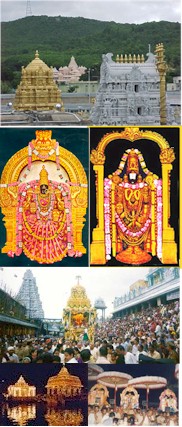Welcome to Adiyen Sri Ramanuja Dasan !
" Srimathe Ramanujaya Namaha !"
(89. Ans. Contd.) This arrangement is intentional. The journey through the temple and through the labyrinth of corridors symbolises that a devotee must specifically seek God. A devotee needs devotion and must be willing to make sacrifices to reach the presence of God. The walk through each inner layer of a temple gives one the feeling that one must specifically seek God. A devotee needs devotion and must be willing to make sacrifices to reach the presence of God. The walk through each inner layer of a temple gives one the feeling that one must penetrate through layers and layers of oneself before discovering the inner self. Once a devotee reaches the sanctum sanctorum, s/he has reached the ultimate destination. That is, the individual has nothing further to seek; everything has been revealed.
Ancient Hindu scholars recognised that symbols and symbolism are more effective in communicating rich messages than speeches or discourses. For example, telling a simple individual that "God is within you" or "Aham Brahmasmi", is unlikely to convey the great concept to the individual. Scholars understood that most individuals think in simple terms and need to transpose abstract ideas on to a physical form. Perhaps this is why religious scholars illustrated formless concepts through stories, art, and physical manifestations of God so that the average individual could relate to them. This way, with learning and maturity, the individual could eventually make the connection between the physical and the formless concepts such as atman, nirvana, or moksha. Symbolism simply connects the physical with the spiritual.
Apart from the above reasons Prakarams are also meant to give security to the temple and are almost part of every temple. According to Vaikhanasa Samhithas there can be up to 7 Prakarams in a Temple, And those can be constructed as and when required by the temple. Srirangam temple is having 7 Prakarams which is Uttamottama category.
90. Q .: When was the Vimanam of Ananda Nilayam got gold covering? who did it?
Ans .: Gold Covering of Ananda Nilaya Vimanam, The first mention of Vimana is during the renovation work of the temple between the 12th and 13th century A.D. when a second wall was constructed around the sanctum sanctorum enclosing the first wall to support the weight of the vimana. The Pallava king Sundara Pandya gifted the gold gilted Kalasam. Viranarasingaraya, a Pallava allied king performed thulabhara (weighing oneself) against gold and the same was used for making the gold plated copper sheets to cover the Vimana.This phase of construction is usually agreed as the fourth phase of Tirumala temple construction out of seven.
In the 1950s, it was discovered that the Gold was getting old and besides, parts of the roof inside was caving into the Sanctum Sanctorum. The TTD decided to replace the aging metal and fix the roof also. So during the year 1958 in the AstaBandhana Maha Samprokshana, All the gold was removed and painstakingly, the damaged levels of the roof below were fixed with cement and extra strength metal grouting reinforcement. During this period in mid-1960s, no worship could be performed in the Sanctum Sanctorum and so the "power" of the chief deity was shifted into a temporary idol carved and placed elsewhere in the temple. All the worship was performed in this new "Bala Aalaya" (Child Temple). It took 5 years for the carpenters and builders to get dies of the nooks and crannies of the Roof and finally copper plates were cast into those shapes. Long nails of the 900s AD were removed and replaced with solid cement and metal grouting using 20th century construction techniques. The copper plates were then installed and fixed in place. Fine "Aparanji" (the best quality) gold was chiseled into plates and riveted onto the copper plates.
A grand ceremony of sanctifying the new grand, golden Ananda Nilaya Vimanam took place in 1970 with "Ashta Bandhana Maha Samprokshanam". The ceremony has been repeated ever since once every 12 years to undertake repairs in the temple.
Jai Srimannaryana !
Thanks for your valuable time. Visit our web site again for more information and latest updates.

